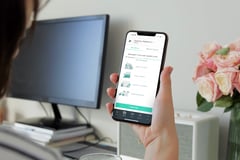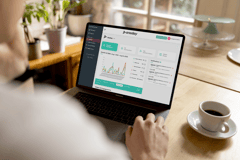If you happen to be the type of person that doesn’t feel entirely comfortable on-camera, I have some great news for you – you’re not alone. Even better, an initial reluctance to step into the spotlight can actually be an asset for your senior living community’s video storytelling efforts.
To that point, I wouldn’t necessarily consider myself someone that’s naturally comfortable being the star of the show. However, I’ve picked up some essential video best practices from my own experiences, along with tips from sales and marketing teams, that I want to share with you.
With these six tips, you’ll not only feel far more comfortable on-camera but, more importantly, create video content that connects with your target audience.
1. Don’t Be Afraid to Play Around
My first tip for being on camera is the most important one – never feel as if you have to be perfect. No one expects perfection, and, more often than not, little flubs allow you to come across as more authentic and vulnerable.
That’s not to say you want your OneDay Resident Stories to be disjointed and hard to follow, though. Find a middle ground and practice your presentation skills by recording yourself, maybe playing around a bit and speaking on a topic you’re passionate about. Afterward, review your recording and look for areas to improve upon. You can even send the video to friends and family for some outside feedback.
2. Personalize The Process
Chances are you feel totally at ease speaking directly to someone you know very well. You can leverage that ease by putting a picture of that familiar face just off-camera, and imagine you’re talking to that person while recording your video. That comfort will shine through in your recording, making the audience feel as if you’re speaking solely to them.
3. Stay Aware of Your Pace
If you’re like most people, you probably speak faster than you’re aware of during everyday conversation. But that rapid pace usually doesn’t lend itself to a clear and communicative video. And if you’re a bit nervous while recording, there’s a good chance you tend to speak even faster.
I suggest focusing on your breathing to maintain a more deliberate pace while talking to the camera. This way, you’re regulating both your breathing and speech patterns to maintain an even keel. Just don’t get so measured with your speech that it hides your enthusiasm and approachability. Remember, prospects, families, and employees want to see your passion come through in your videos.
4. Imitate and Pretend
Your favorite internet or TV personalities can also provide some helpful hints on ways to improve engagement with your audience. Next time you’re watching one of your favorites, take notes on any traits or small flourishes that connect with you. Then try to integrate some of those notes into some practice videos on your own.
I’m obviously not recommending you flat-out steal someone else’s personality, but there’s nothing wrong with learning from the best. In this instance, a bit of pretend and imitation really is a sincere form of flattery.
5. Have Passion For Your Topic
This tip might be the broadest of the six but is still essential in your video storytelling. The easiest way to lose your audience’s attention is to lack enthusiasm and a genuine passion for your topic. Simply put, if you’re not “feeling it,” the viewer won’t “feel it,” either.
Therefore, if you have a lot on your mind and just can’t seem to exude that critical passion when recording a video, set it aside for a bit and come back to it later. Also, don’t forget about all of the handy editing functions in OneDay’s platform that can help you quickly and easily find the diamond in the rough cut of your video. There’s something to be said for “fixing it in post.”
6. Practice, Practice, Practice
My final tip might seem obvious but is absolutely critical to an effective video marketing strategy. Every aspect of your video storytelling will improve with practice, from your on-camera comfort level to speech patterns and editing.
The best way to practice is to simply open the OneDay platform and dive in. Start with practice videos on your own, then expand to other team members you plan to use in your video content. Before long, you’ll feel like an old pro with your Resident Stories, and your audience is bound to recognize the difference.
And as always, if you happen to have any questions or issues along the way, don’t hesitate to contact our Customer Success team. Our experience and expertise are your experience and expertise, and we’re here to help you reach your goals.




